NATIONAL ZOO AND CONSERVATION BIOLOGY INSTITUTE
Testing the Waters: Coral Nurseries and Climate Change
What makes (or breaks) a coral’s ability to survive rising sea temperatures? It’s a puzzling predicament, and scientists are hoping coral nurseries can help crack the code. To test the waters, they grow brown rice coral and blue rice coral in various temperatures and conditions, then reintroduce fragments into the ocean. Suspended from a “tree” above the sea floor, these corals are teaching Smithsonian Conservation Biology Institute scientist Mike Henley whether corals grown in warmer waters fare better than their cold-water counterparts.
:focal(229x71:230x72)/https://tf-cmsv2-smithsonianmag-media.s3.amazonaws.com/blogging/featured/coral-mike-henley-web-011.jpg)
What makes (or breaks) a coral’s ability to survive rising sea temperatures? It’s a puzzling predicament, and scientists are hoping coral nurseries can help crack the code. To test the waters, they grow brown rice coral and blue rice coral in various temperatures and conditions, then reintroduce fragments into the ocean. Suspended from a “tree” above the sea floor, these corals are teaching Smithsonian Conservation Biology Institute scientist Mike Henley whether corals grown in warmer waters fare better than their cold-water counterparts.
What are your favorite facts about corals?
Many people are surprised to learn that corals are animals! We compare them to plants in that if they fragment, or break apart, they are able to reproduce asexually — like how you might give the cutting of a houseplant to a friend. The difference is that when corals grow, they have the ability to reconnect and fuse together. Eventually, they can grow back into one colony.
Another fun fact is that you can set your watch by the coral spawn. In a given area, most of them have tuned their reproduction to the same hours of the same few days of the same few months every single year. How do brainless animals know to spawn all at the same time? It’s really fascinating.
What corals are you working with in the nursery?
The two corals I am working with are Montipora capitata, commonly known as the brown rice coral, and Montipora flabellata, or the blue rice coral. The cool thing about these corals is that the adults have a toxin in them, and this toxin is also incorporated into the eggs.
Not many corals have toxins, and we’re not entirely sure why these species do. It is possible that the toxin makes the adults and larvae distasteful to potential predators, or maybe it helps the young corals find a spot on the reef to settle. Whatever the reason, the toxins in the eggs makes breeding this species in the lab a bit tricky. If we have 100 egg-and-sperm bundles in our sample in a small tube, and an egg breaks, the toxin could kill the sperm instantaneously — and we would lose our entire sample!
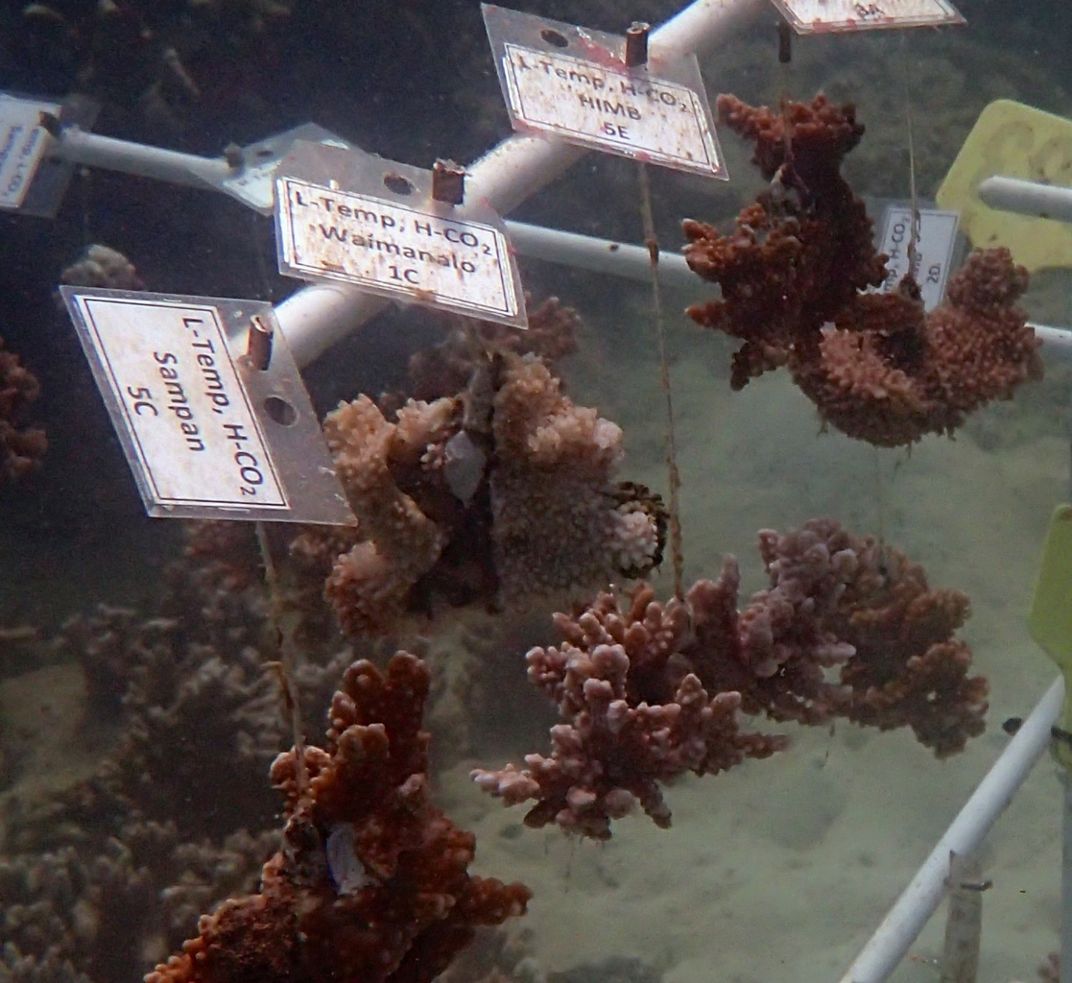
What do you find most exciting about this project?
One of the most exciting questions I’m hoping to answer with this research is whether we can predict which corals are going to do better under warming ocean temperatures. Coral reefs, as a whole, are struggling to keep up with changing environmental conditions — including temperature fluctuations — but there may be some hope that certain species are able to acclimatize and adapt faster than we think. This study is just one way to help us determine corals’ resiliency to these pressures.
How did you get the coral fragments used in this study?
I received the coral fragments in January 2019 from my colleague Chris Jury, whose long-term experiment was concluding. Conveniently enough, his lab is located right next to ours on Coconut Island!
About three years ago, Chris harvested the “parent” corals from Kaneohe Bay and elsewhere around Oahu. At the time, they were small fragments. Today, some are the size of dinner platters. He grows the corals in outdoor tanks, so they receive the same flow-through seawater and natural sunlight as the corals in Kaneohe Bay. The difference is, the tanks allow him to manipulate the water temperature and pH regime (make it more acidic or basic).
For both the brown rice coral and blue rice coral species, one parent coral was grown in water with a low temperature and low pH; another in low temperature and high pH; a third in high temperature, low pH; and the last in high temperature, high pH. I am following those same individual genotypes as Chris labeled. I’m interested to see if their growth is maintained or reversed, if there are any long-term impacts from the different conditions in which they were grown, and if they will grow at the same rate when exposed to the same ocean conditions.
From each of the parent corals (there are several per treatment), I made five small fragments. To the best of my ability, I tried to cut them to about the same size. Most are small enough to easily fit in the palm of my hand.
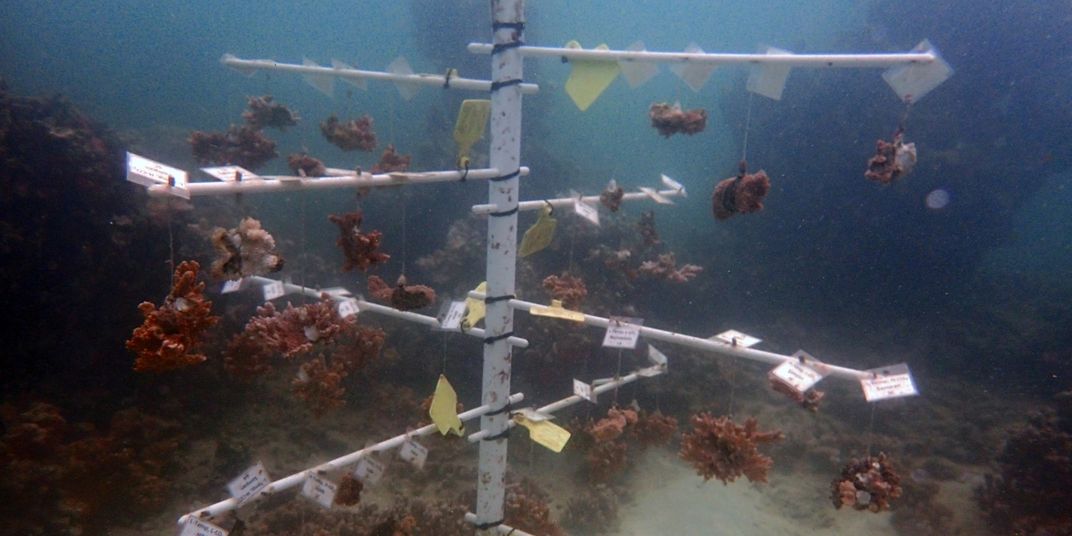
How did you build the coral tree?
The “trunk” of the tree is made from a piece of one inch-thick PVC pipe. To keep the tree upright, its base is held in the sand with a duckbill anchor, and an orange buoy is attached to the top by a thick nylon rope. The top of the buoy is about 10 feet below the water’s surface, which allows boats to go by without snagging my experiment in their wake! Holes were drilled into the trunk and inserted fiberglass rods, which serve as “branches.”
To attach the coral fragments to the tree, I wrapped a thick piece of fishing line and an aluminum crimp around the coral itself. I threaded the extra string of the fishing line through holes in the branches, leaving enough space for the coral to dangle below. To keep tabs on which coral is which, I attached an identification tag that specifies the species of coral, the conditions in which it was grown and the tag number. I hung the brown rice coral fragments on the tree in January 2019 and the blue rice corals in February 2019.
The tree sits just a short snorkel from the shores of the Hawaii Institute of Marine Biology. At least twice a month, I swim out to the site to make sure none of the coral fragments have been knocked off or loosened from the tree.
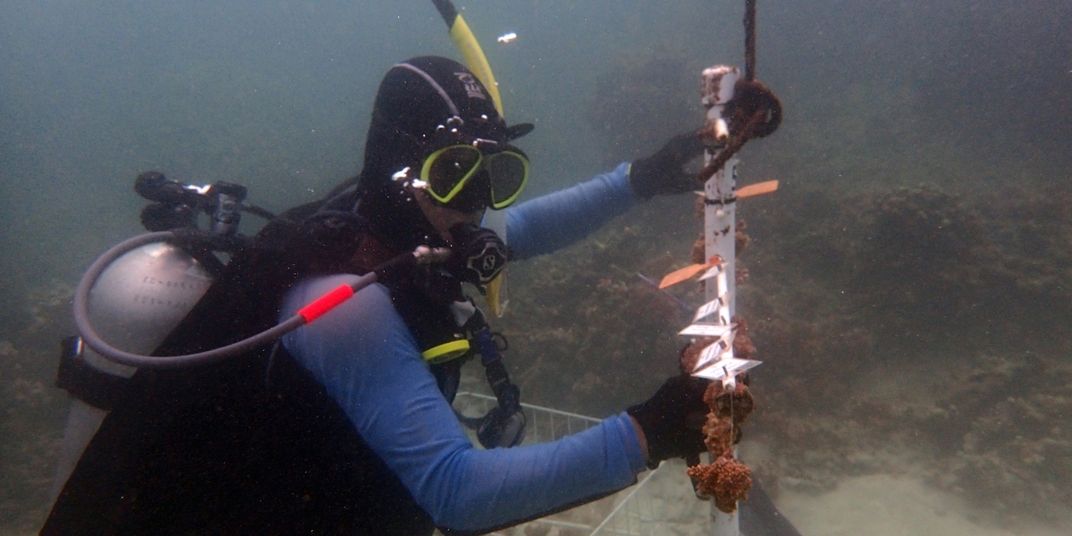
Why did you put coral on a tree and not in the adjacent reef?
Suspending the coral fragments from a tree helps reduce several factors that can contribute to their mortality. If I put the coral onto a plate, that plate will likely grow algae. It would take many, many hours to scrape the algae off the coral and its plate. Kaneohe Bay is also a heavily sedimented area, and it’s not uncommon for small corals to be smothered by the sand.
Although we don’t have a problem with crown of thorns sea stars here in Hawaii, they do in other parts of the world, including Moorea, where there are also coral trees and a nursery. Suspending corals is pretty effective at preventing sea star predation.
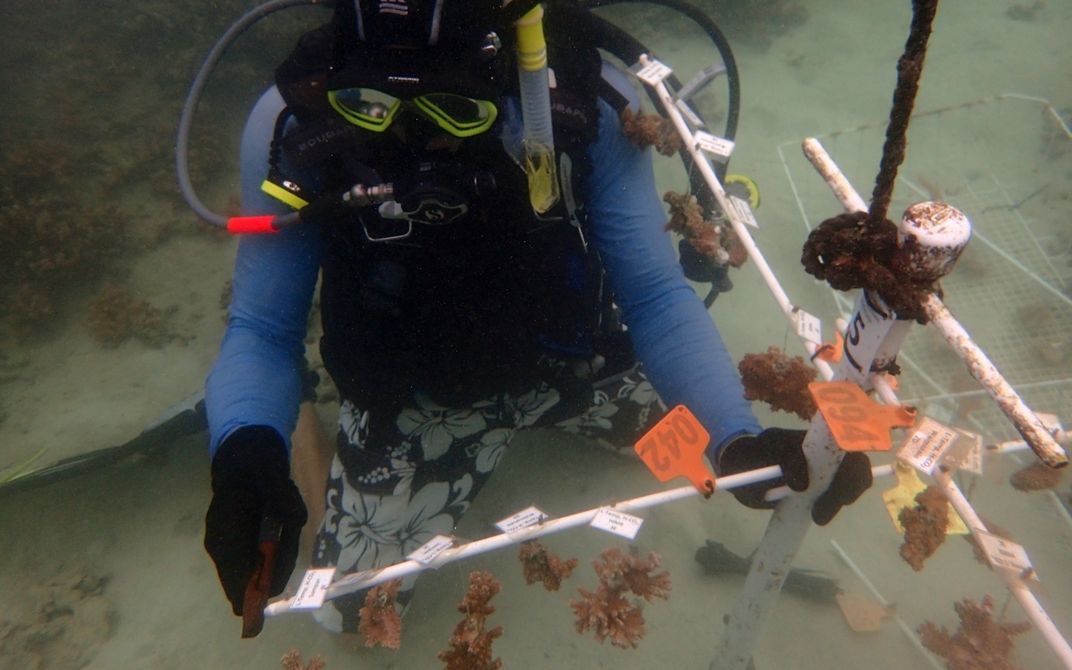
Do any other animals eat brown rice coral or blue rice coral?
Since the fragments on the coral trees sway with the waves, many of the fish that normally eat them have a hard time getting to them. Having said that, I just did my six-month measurements, and several oysters settled on some of my blue rice corals. That particular species has an encrusting growth form. In other words, it grows over the substrate rather than forming large, tall branches. Only the top has live tissue; the underside does not. This leaves its skeleton exposed. Oysters do not root on live coral tissue, so that means the underside of the blue rice coral is prime real estate for oysters.
One or two oysters do not really affect the corals, but if more of them congregate, it can. Size-wise, they are relatively tiny — about the length of a nickel or quarter. I don’t want them to influence my weight measurements, so I remove the oysters from each fragment whenever I find them. One of my corals increased in weight from 10 grams to 12 grams. Had I not removed the oysters, it would have weighed 22 grams!
The oysters can attract their own predators, too. In the last 6 months, I lost a blue rice coral where literally half of the coral had been sheared off by, I suspect, a puffer fish. They have large beaks built for crushing and shearing. They are not after the corals, per se, but the oysters that have settled on the corals help make up a nice buffet line for the puffers.
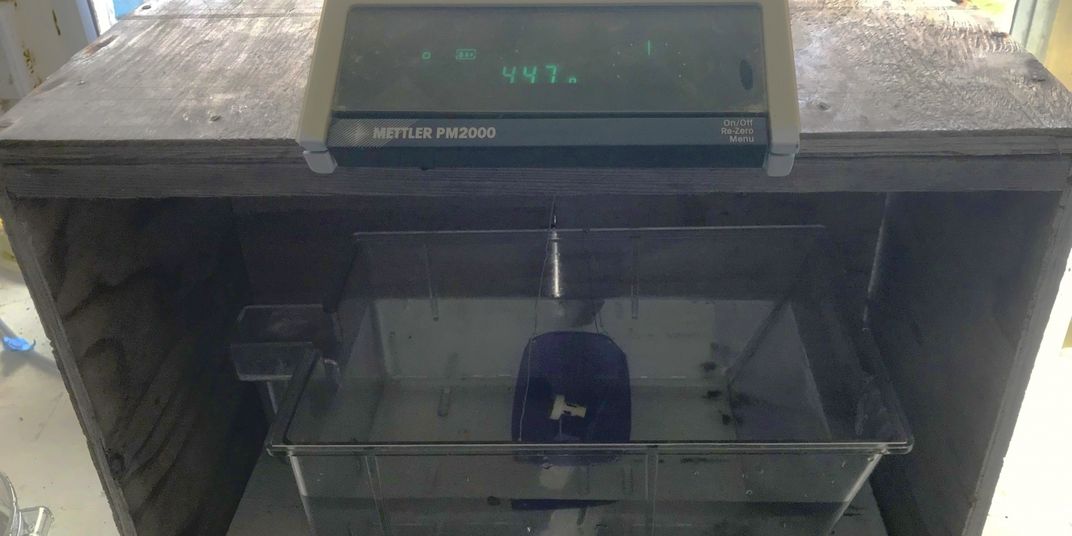
How do you measure a coral fragment’s growth?
Corals grow in different shapes, sizes and forms. This can make measuring their growth a challenge. If I were to take the coral fragment out of the water and place it on a scale, this measurement would include the weight of the coral, plus the weight of the water it retained. Allowing the coral to dry is not ideal, either, because doing so causes it to produce a mucus and add to its weight, and could possibly be detrimental to the coral’s health if it dries out too much.
To combat these anomalies, I am taking the fragments’ buoyant weight instead. The scale I use is similar to the one you would find in the produce isle of the grocery store, where the tray is suspended beneath the dial. That way, I can measure the coral’s weight, and it can remain underwater.
Is there any downside to the coral tree?
From previous coral tree studies, scientists have found that corals growing in suspension on a tree might have a slightly less dense skeleton compared to those that grow on a reef. When you put a coral on a reef, it expends quite a bit of energy gluing and solidifying itself into the substrate — akin to a plant putting down its roots. Corals require a robust, dense skeleton in order to withstand waves and storms. However, corals grown in suspension are not compacting down onto a substrate since they don’t have any foundation to hold on to, so their skeletons just grow outward. They seem to grow faster, but the tradeoff might be that their skeleton is less dense.
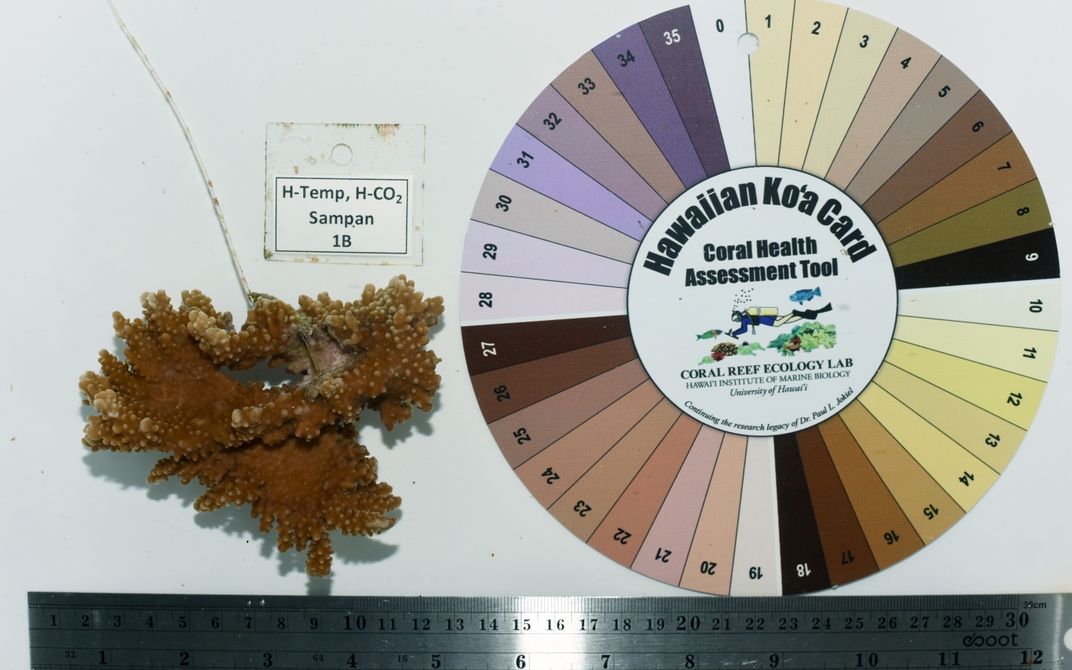
What causes a coral to bleach?
Usually when you see swaths of coral reefs that have bleached, it is temperature induced. The main food source for shallow, reef-building corals — including brown rice coral and blue rice coral — is a microscopic protozoa called zooxanthellae. This algae lives inside the coral tissue. They have a symbiotic relationship: the coral protects the zooxanthellae, and in turn the zooxanthellae provides the coral with food.
Because corals are animals, they can’t photosynthesize. But zooxanthellae can. The waste product of their photosynthesis are sugars that feed the coral. When ocean temperatures warm, however, there is a breakdown in the symbiosis. Warm temperatures speed up the zooxanthellae’s metabolism, causing it to produce a toxic compound. In response, the coral expel the algae. Since these species get most of their coloring from the zooxanthellae, the expulsion causes the corals to appear lighter in appearance — changing from dark brown to a paler brown.
When bleaching first occurs, the coral is still very much alive. Corals are related to sea anemones and jellyfish. They have stinging tentacles that can capture zooplankton. Still, the majority of their food comes from zooxanthellae.
A bleached coral is not necessarily a dead coral. Bleaching indicates that a coral is stressed. If the water temperature decreases, coral can recuperate and regain their zooxanthellae. That said, if the warming trend happens for an extended period of time, and the coral goes too long without zooxanthellae, it can absolutely die. It depends on the individual coral’s response.
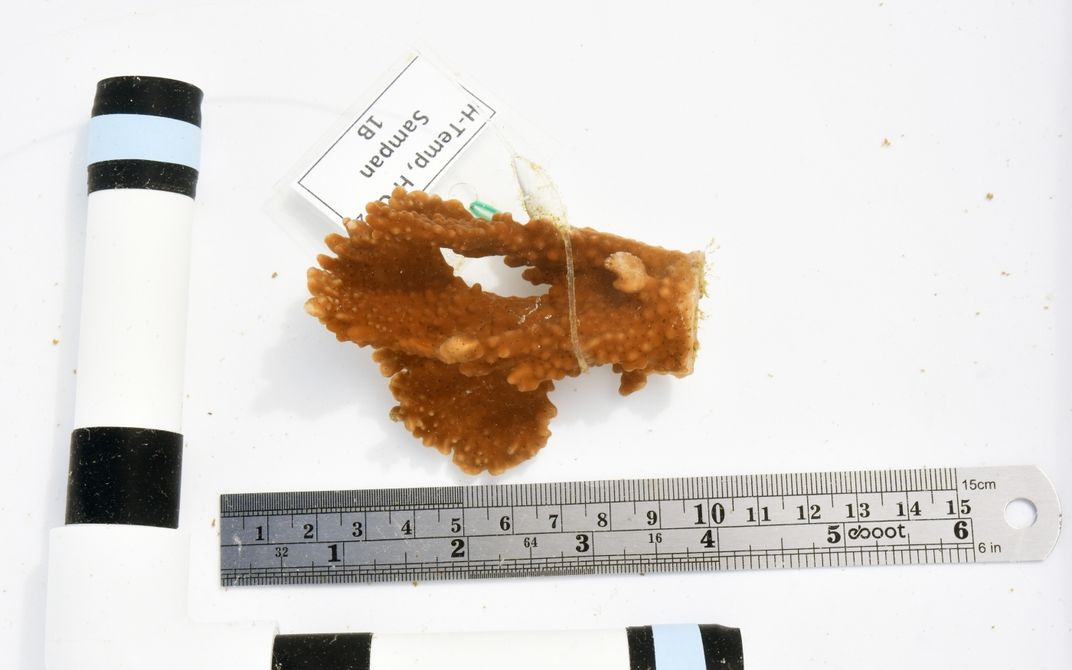
Have you noticed any bleaching in your corals?
Somewhat, yes. To see if there is any evidence of bleaching, I take photos of the corals next to a color card. Although some of the brown rice corals are slightly lighter in color and somewhat pale, they aren’t completely bleached. Most of them are still a nice dark brown color. However, some of the blue rice corals are absolutely bleaching, either paling or turning from a dark blueish-purplish-brown to a more pastel tone.
I will be interested to see if the corals that have been exposed to high temperature treatments bleach any more or less notably than the ones grown in low temperature treatments.
What makes you optimistic about this research?
Certain reef restoration efforts have been successful; they are a good, important step towards helping some corals recover and cope with stress from climate change. Other coral species, though, don’t fare as well, and it’s just as important to keep that in mind. As ocean temperatures continue to rise, the fate of all coral species hangs in the balance. That’s why keeping our eyes on the big picture, and figuring out how corals respond to climate change, is so crucial right now.
This article appears in the October 2019 issue of National Zoo News. Partners in this study include Mary Hagedorn, Smithsonian Conservation Biology Institute; Christopher Jury, Hawaii Institute of Marine Biology; Rob Toonen, Hawaii Institute of Marine Biology; and Ken Neidermeyer, Coral Restoration Foundation.

